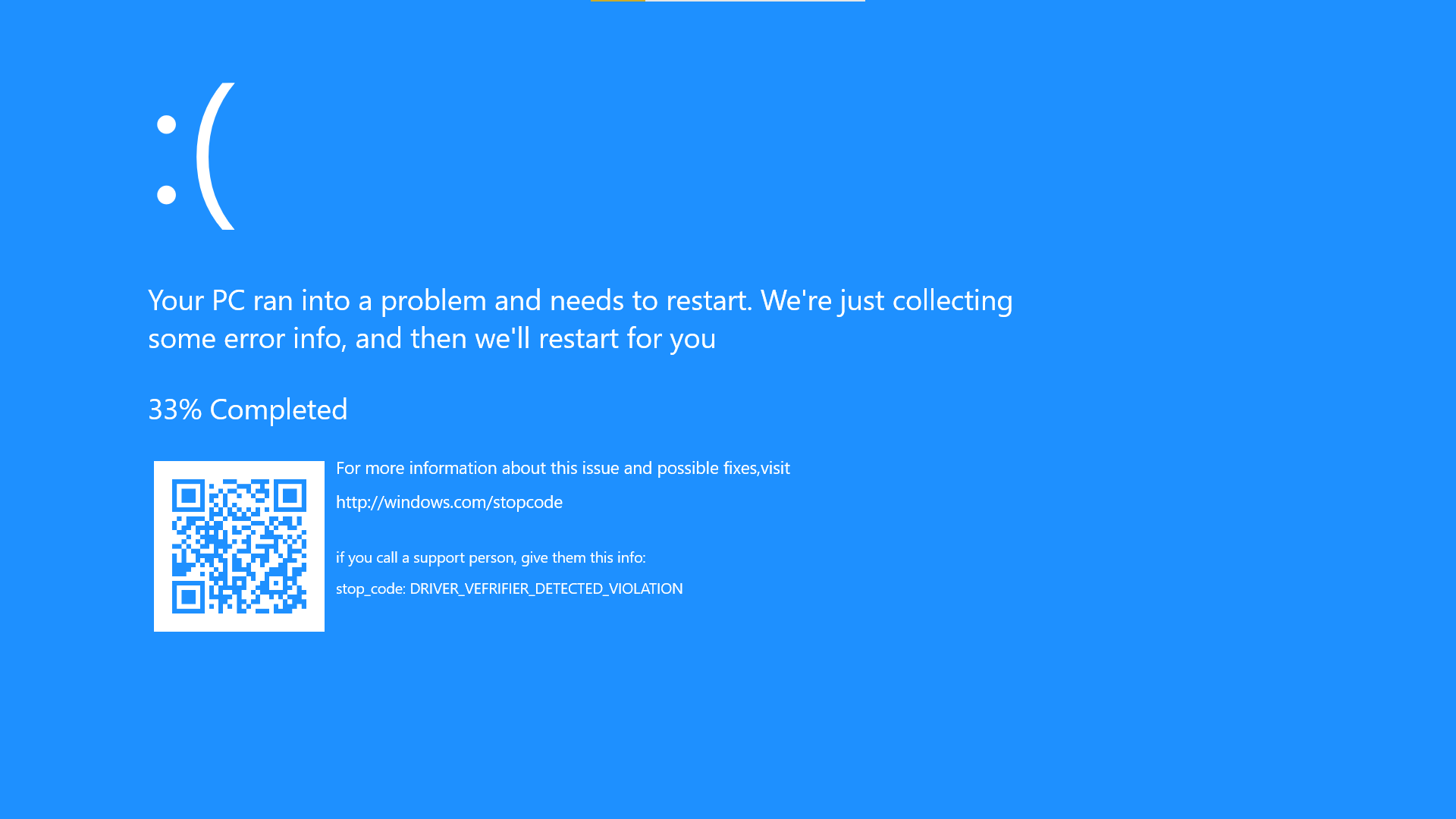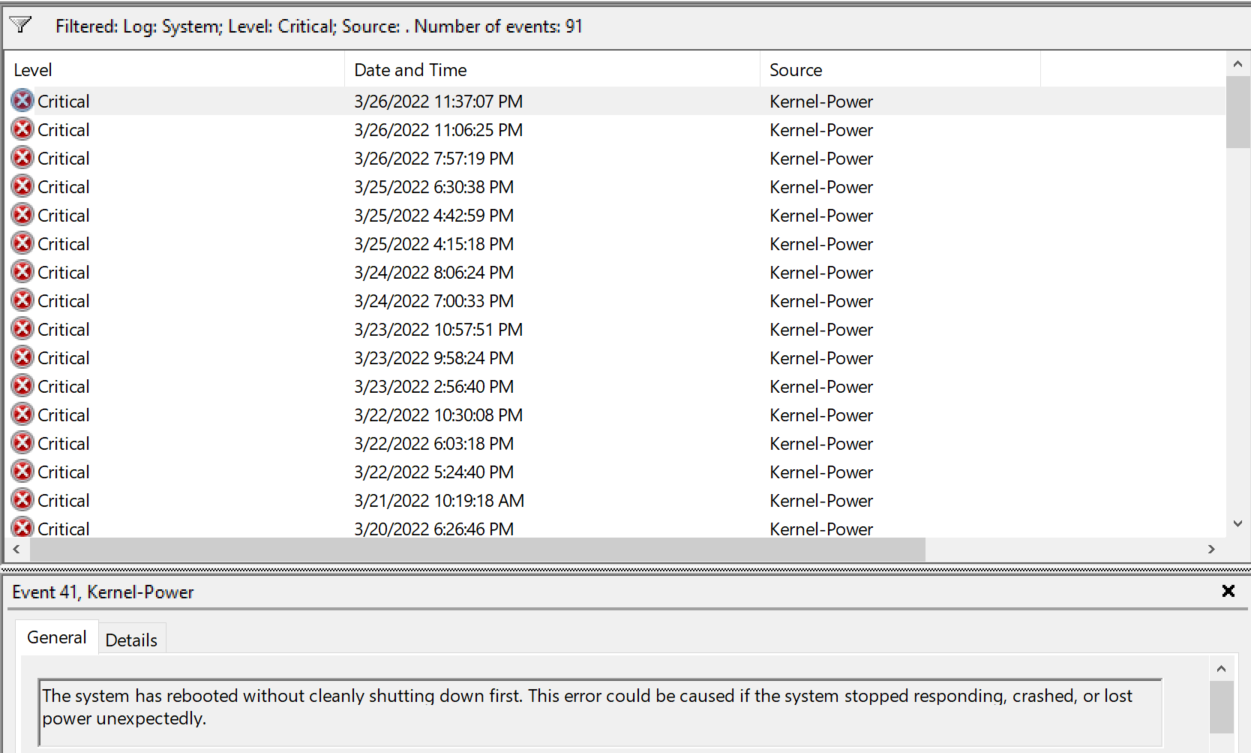Microsoft (R) Windows Debugger Version 10.0.22549.1000 AMD64
Copyright (c) Microsoft Corporation. All rights reserved.
Loading Dump File [C:\WINDOWS\MEMORY.DMP]
Kernel Bitmap Dump File: Full address space is available
************* Path validation summary **************
Response Time (ms) Location
Deferred srv*
Symbol search path is: srv*
Executable search path is:
Windows 10 Kernel Version 19041 MP (16 procs) Free x64
Product: WinNt, suite: TerminalServer SingleUserTS
Edition build lab: 19041.1.amd64fre.vb_release.191206-1406
Machine Name:
Kernel base = 0xfffff800`1401e000 PsLoadedModuleList = 0xfffff800`14c482b0
Debug session time: Sun Mar 27 00:29:33.307 2022 (UTC + 8:00)
System Uptime: 0 days 0:00:05.019
Loading Kernel Symbols
...............................................................
......................................
Loading User Symbols
Loading unloaded module list
...
For analysis of this file, run !analyze -v
nt!KeBugCheckEx:
fffff800`144152e0 48894c2408 mov qword ptr [rsp+8],rcx ss:0018:ffffea87`e5e06520=00000000000000c4
5: kd> !analyze -v
*******************************************************************************
* *
* Bugcheck Analysis *
* *
*******************************************************************************
DRIVER_VERIFIER_DETECTED_VIOLATION (c4)
A device driver attempting to corrupt the system has been caught. This is
because the driver was specified in the registry as being suspect (by the
administrator) and the kernel has enabled substantial checking of this driver.
If the driver attempts to corrupt the system, BugChecks 0xC4, 0xC1 and 0xA will
be among the most commonly seen crashes.
Arguments:
Arg1: 0000000000000062, A driver has forgotten to free its pool allocations prior to unloading.
Arg2: ffffb90f949ffcc0, name of the driver having the issue.
Arg3: ffffb90f9492b570, verifier internal structure with driver information.
Arg4: 0000000000000002, total # of (paged+nonpaged) allocations that weren't freed.
Type !verifier 3 drivername.sys for info on the allocations
that were leaked that caused the bugcheck.
Debugging Details:
------------------
Unable to load image \SystemRoot\system32\DRIVERS\gvm.sys, Win32 error 0n2
KEY_VALUES_STRING: 1
Key : Analysis.CPU.mSec
Value: 3140
Key : Analysis.DebugAnalysisManager
Value: Create
Key : Analysis.Elapsed.mSec
Value: 14338
Key : Analysis.Init.CPU.mSec
Value: 499
Key : Analysis.Init.Elapsed.mSec
Value: 10589
Key : Analysis.Memory.CommitPeak.Mb
Value: 83
Key : WER.OS.Branch
Value: vb_release
Key : WER.OS.Timestamp
Value: 2019-12-06T14:06:00Z
Key : WER.OS.Version
Value: 10.0.19041.1
FILE_IN_CAB: MEMORY.DMP
BUGCHECK_CODE: c4
BUGCHECK_P1: 62
BUGCHECK_P2: ffffb90f949ffcc0
BUGCHECK_P3: ffffb90f9492b570
BUGCHECK_P4: 2
IMAGE_NAME: gvm.sys
MODULE_NAME: gvm
FAULTING_MODULE: fffff80956390000 gvm
VERIFIER_DRIVER_ENTRY: dt nt!_MI_VERIFIER_DRIVER_ENTRY ffffb90f9492b570
Symbol nt!_MI_VERIFIER_DRIVER_ENTRY not found.
BLACKBOXNTFS: 1 (!blackboxntfs)
PROCESS_NAME: System
STACK_TEXT:
ffffea87`e5e06518 fffff800`149ebe34 : 00000000`000000c4 00000000`00000062 ffffb90f`949ffcc0 ffffb90f`9492b570 : nt!KeBugCheckEx
ffffea87`e5e06520 fffff800`149fb169 : ffffb90f`9492b570 ffffea87`e5e06610 ffffb90f`949ffb30 ffffb90f`94460040 : nt!VerifierBugCheckIfAppropriate+0xe0
ffffea87`e5e06560 fffff800`144a85e0 : ffffb90f`9492b570 ffffb90f`949ffbd0 00000000`00000001 ffffb90f`94460020 : nt!VfPoolCheckForLeaks+0x49
ffffea87`e5e065a0 fffff800`149dd502 : 00000000`00274000 ffffb90f`949ffb30 fffff800`14c3aeb0 fffff800`14c3aeb0 : nt!VfTargetDriversRemove+0x11a174
ffffea87`e5e06620 fffff800`146c7553 : ffffb90f`949ffb30 ffffea87`e5e06750 00000000`00000001 00000000`ffffffff : nt!VfDriverUnloadImage+0x3e
ffffea87`e5e06650 fffff800`1477e001 : 00000000`00000000 fffff800`ffffffff ffff241c`00000001 ffffa303`e1ed1240 : nt!MiUnloadSystemImage+0x2eb
ffffea87`e5e067f0 fffff800`1477df2e : ffffb90f`8c4e4a60 ffffea87`e5e06a40 00000000`00000000 00000000`00000000 : nt!MmUnloadSystemImage+0x41
ffffea87`e5e06820 fffff800`146913e0 : ffffb90f`8c4e4a60 ffffea87`e5e06a40 ffffb90f`8c4e4a60 fffff800`1465b7df : nt!IopDeleteDriver+0x4e
ffffea87`e5e06870 fffff800`14226357 : 00000000`00000000 00000000`00000000 ffffea87`e5e06a40 ffffb90f`8c4e4a90 : nt!ObpRemoveObjectRoutine+0x80
ffffea87`e5e068d0 fffff800`1422627e : 00000000`00000008 00000000`00000000 ffffb90f`8c4e4a60 00000000`c0000365 : nt!ObfDereferenceObjectWithTag+0xc7
ffffea87`e5e06910 fffff800`1474814a : 00000000`00000008 00000000`00000008 00000000`ffffffa1 00000000`00001000 : nt!HalPutDmaAdapter+0xe
ffffea87`e5e06940 fffff800`14a6bda3 : ffffb90f`945ff658 ffffb90f`945ff658 ffffea87`e5e06b80 00000000`00000000 : nt!IopLoadDriver+0x76a
ffffea87`e5e06b10 fffff800`14a6072a : ffffffff`ffffffa1 ffffa303`e51fefd0 00000000`00000000 fffff800`116d7750 : nt!IopInitializeSystemDrivers+0x157
ffffea87`e5e06bb0 fffff800`147a485b : fffff800`116d7750 fffff800`14c64fe8 fffff800`147a4820 fffff800`116d7750 : nt!IoInitSystem+0x2e
ffffea87`e5e06be0 fffff800`14373995 : ffffb90f`89ec3080 fffff800`147a4820 fffff800`116d7750 a1a64fe8`ce8b48d7 : nt!Phase1Initialization+0x3b
ffffea87`e5e06c10 fffff800`1441c938 : fffff800`11a4c180 ffffb90f`89ec3080 fffff800`14373940 058b4800`0040b7e8 : nt!PspSystemThreadStartup+0x55
ffffea87`e5e06c60 00000000`00000000 : ffffea87`e5e07000 ffffea87`e5e01000 00000000`00000000 00000000`00000000 : nt!KiStartSystemThread+0x28
IMAGE_VERSION: 1.7.0.0
STACK_COMMAND: .cxr; .ecxr ; kb
FAILURE_BUCKET_ID: 0xc4_62_VRF_LEAKED_POOL_IMAGE_gvm.sys
OS_VERSION: 10.0.19041.1
BUILDLAB_STR: vb_release
OSPLATFORM_TYPE: x64
OSNAME: Windows 10
FAILURE_ID_HASH: {a0c4665d-e60a-f4d0-aeeb-0605adf8a6ef}
Followup: MachineOwner
---------
5: kd> lmvm gvm
Browse full module list
start end module name
fffff809`56390000 fffff809`56604000 gvm (no symbols)
Loaded symbol image file: gvm.sys
Image path: \SystemRoot\system32\DRIVERS\gvm.sys
Image name: gvm.sys
Browse all global symbols functions data
Timestamp: Wed Sep 23 03:38:16 2020 (5F6A52A8)
CheckSum: 00065EDA
ImageSize: 00274000
File version: 1.7.0.0
Product version: 1.7.0.0
File flags: 2 (Mask 3F) Pre-release
File OS: 40004 NT Win32
File type: 3.7 Driver
File date: 00000000.00000000
Translations: 0409.04b0
Information from resource tables:
CompanyName: Google LLC
ProductName: Android Emulator Hypervisor Driver for AMD Processors
InternalName: Android Emulator Hypervisor Driver for AMD Processors
OriginalFilename: gvm.sys
ProductVersion: 1.7
FileVersion: 1.7
FileDescription: Android Emulator Hypervisor Driver for AMD Processors
LegalCopyright: Copyright (c) 2019 Google LLC

